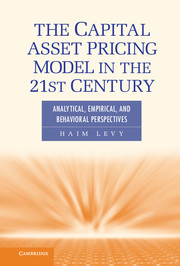 The Capital Asset Pricing Model in the 21st Century
The Capital Asset Pricing Model in the 21st Century Book contents
- Frontmatter
- Contents
- Preface
- 1 Introduction
- 2 Expected Utility Theory
- 3 Expected Utility and Investment Decision Rules
- 4 The Mean-Variance Rule (M-V Rule)
- 5 The Capital Asset Pricing Model
- 6 Extensions of the Capital Asset Pricing Model
- 7 The Capital Asset Pricing Model Cannot Be Rejected
- 8 Theoretical and Empirical Criticism of the Mean-Variance Rule
- 9 Prospect Theory and Expected Utility
- 10 Cumulative Decision Weights
- 11 The Mean-Variance Rule, the Capital Asset Pricing Model, and the Cumulative Prospect Theory
- References
- Name Index
- Subject Index
11 - The Mean-Variance Rule, the Capital Asset Pricing Model, and the Cumulative Prospect Theory
Coexistence
Published online by Cambridge University Press: 05 June 2012
- Frontmatter
- Contents
- Preface
- 1 Introduction
- 2 Expected Utility Theory
- 3 Expected Utility and Investment Decision Rules
- 4 The Mean-Variance Rule (M-V Rule)
- 5 The Capital Asset Pricing Model
- 6 Extensions of the Capital Asset Pricing Model
- 7 The Capital Asset Pricing Model Cannot Be Rejected
- 8 Theoretical and Empirical Criticism of the Mean-Variance Rule
- 9 Prospect Theory and Expected Utility
- 10 Cumulative Decision Weights
- 11 The Mean-Variance Rule, the Capital Asset Pricing Model, and the Cumulative Prospect Theory
- References
- Name Index
- Subject Index
Summary
Introduction
In deriving the Mean-Variance (M-V) rule and the Capital Asset Pricing Model (CAPM), one assumes explicitly or implicitly normal distributions of returns and risk aversion. With these assumptions, it emerges that the variance of the portfolio's return is the measure of the investment's risk. In Chapter 8, we saw that although normality of returns is statistically rejected, the economic loss from assuming normality when the distributions are actually not normal is relatively small. Moreover, in Chapter 4, we saw that even if the distributions of returns are not normal, the M-V rule can be employed as an approximation to expected utility, as long as risk aversion is assumed. Furthermore, it was shown empirically in Chapter 4 that the choices made by the M-V rule are almost fully correlated with the choices made by direct expected utility maximization for a wide set of risk-averse utility function.
Considering the relatively small economic loss involved as a result of the normality assumption, in this chapter we assume that the M-V and the CAPM are derived based on this normality assumption, within the expected utility framework, rather than as an approximation to expected utility. However, even in this framework, as we saw in Chapters 9 and 10, the M-V and the CAPM are questionable for the following reasons:
By the Prospect Theory (PT), people maximize a value function, which is defined on change of wealth (gains and losses) rather than on total wealth; by expected utility, the M-V rule and the CAPM are defined on total wealth.
To derive the M-V rule and the CAPM, risk aversion is needed, whereas by PT, the value function has a risk-seeking segment. The risk- seeking segment of preference is steeper than the risk-aversion segment, implying loss aversion.
Adopting the modified version of the PT, called Cumulative Prospect Theory (CPT), people employ cumulative decision weights. Thus, the cumulative distribution of returns is transformed, and in calculating the expected value (utility), the transformed distribution rather than the original distribution is employed. This seems to be a “deathblow” to the M-V rule and the CAPM because even if the original distribution of returns is normal, generally the transformed distribution is not. Moreover, although the normal distribution is symmetric, implying that skewness is equal to zero, the transformed distribution may be skewed, thus relying only on the mean, and variance may be misleading because there is ample evidence that investors like positive skewness and dislike negative skewness.
For the preceding reasons, it would seem that the CPT paradigm and the M-V rule plus the CAPM paradigm cannot coexist. Moreover, the fact that Markowitz and Sharpe won the Noble Prize in Economics in 1990 for developing the M-V rule and the CAPM, and Kahneman won the Noble Prize in Economics in 2002 for introducing the PT, emphasizes the seeming contradiction between these two paradigms and makes it even more uncomfortable for researchers. If one adopts PT, it seems the M-V and the CAPM should be abandoned. If one employs the M-V and the CAPM, the important evidence regarding subjects’ choices, as clearly shown in PT experiments, are ignored.
- Type
- Chapter
- Information
- The Capital Asset Pricing Model in the 21st CenturyAnalytical, Empirical, and Behavioral Perspectives, pp. 372 - 404Publisher: Cambridge University PressPrint publication year: 2011


